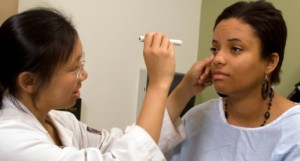The Emory School of Medicine’s new curriculum was introduced in 2007 in order to create connections between faculty and students that last throughout the entire four years of medical school, “longitudinal†relationships much like those that should exist ideally between doctors and their patients.

Students practice medical exams
Based on the kind of students who are attracted to Emory and on what they learn and model from their faculty mentors, these students are expected to grow not just in knowledge during their time at Emory, but also in compassion, curiosity, and commitment—and to use these traits wisely in serving their profession and community.
At the heart of the curriculum is a highly popular system of faculty advisers, each faculty mentor paired with eight or nine students.
These groupings are designated as “societies†named for historical medical luminaries—for example, Osler, Semmelweis, Lister, Harvey.
Faculty advisers who lead these societies in each class are chosen carefully, their salaries underwritten by the medical school so they can relinquish three half-days per week from their regular clinical and/or research duties to spend time with some or all of “their†students.
As the class of 2011 moves through the new curriculum, all now have completed the 18-month Foundations of Medicine phase, a whole-person approach section that combines clinical medicine and basic fundamentals of science, social sciences, humanities and public health.
This is not my father’s or mother’s medical school experience, students say. In the introduction-to-neuroscience module, for example, faculty share the classroom with a baseball player, who demonstrates and explains what a center fielder has to do to catch a fly ball or what a batter must consider before swinging at a ball leaving the pitcher’s hand at 95 mph.
Learn more about the curriculum in the 2009 Emory School of Medicine annual report, and more about the school in Emory Medicine. Read a message from Dean Thomas J. Lawley, MD.

